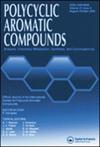Tandem Synthesis and Computational Insights into Triazole and Pyrazole-Based Pyridine Derivatives Targeting EGFR-TK in Cancer Therapy
IF 2.6
3区 化学
Q2 CHEMISTRY, ORGANIC
引用次数: 0
Abstract
Cancer remains one of the leading causes of death worldwide, despite significant advances in treatment. Targeting tyrosine kinases, such as the epidermal growth factor receptor (EGFR), has become a promising approach for the development of anticancer agents. In this study, we designed and synthesized a series of triazole and pyrazole-based pyridine derivatives (7a–c, 10a–c, 11, 14a, and 14b) to target EGFR-TK. Bioisosteric modifications were incorporated into these compounds, based on key pharmacophoric features of established EGFR-TK inhibitors. The compounds were evaluated for cytotoxicity against a range of cancer cell lines, including MCF-7, HepG2, HCT116, and EA hy926. Notably, compounds 14a and 14b, which feature the pyrazolo[3,4-b]pyridine-5-carbonitrile nucleus, demonstrated significant anticancer activity with lower IC50 values across all tested cell lines. These compounds exhibited potent inhibitory effects, indicating their potential as effective EGFR-TK inhibitors. In silico studies, including ADME predictions, molecular docking, and molecular dynamics simulations, further supported their favorable pharmacokinetic profiles and strong binding interactions with EGFR-TK. Our findings suggest that these triazole and pyrazole-based pyridine derivatives could serve as promising candidates for the development of targeted anticancer therapies.
靶向EGFR-TK的三唑和吡唑基吡啶衍生物的串联合成和计算研究
尽管在治疗方面取得了重大进展,但癌症仍然是世界范围内导致死亡的主要原因之一。针对酪氨酸激酶,如表皮生长因子受体(EGFR),已成为开发抗癌药物的一个有前途的途径。在本研究中,我们设计并合成了一系列以三唑和吡唑为基础的吡啶衍生物(7a-c、10a-c、11、14a和14b)靶向EGFR-TK。根据已建立的EGFR-TK抑制剂的关键药效特征,将生物等构修饰纳入这些化合物中。这些化合物对一系列癌细胞系的细胞毒性进行了评估,包括MCF-7、HepG2、HCT116和EA hy926。值得注意的是,化合物14a和14b具有吡唑[3,4-b]吡啶-5-碳腈核,在所有测试细胞系中显示出显著的抗癌活性,IC50值较低。这些化合物表现出强有力的抑制作用,表明它们可能是有效的EGFR-TK抑制剂。包括ADME预测、分子对接和分子动力学模拟在内的计算机研究进一步支持了它们良好的药代动力学特征和与EGFR-TK的强结合相互作用。我们的研究结果表明,这些基于三唑和吡唑的吡啶衍生物可以作为开发靶向抗癌疗法的有希望的候选者。
本文章由计算机程序翻译,如有差异,请以英文原文为准。
求助全文
约1分钟内获得全文
求助全文
来源期刊

Polycyclic Aromatic Compounds
化学-有机化学
CiteScore
3.70
自引率
20.80%
发文量
412
审稿时长
3 months
期刊介绍:
The purpose of Polycyclic Aromatic Compounds is to provide an international and interdisciplinary forum for all aspects of research related to polycyclic aromatic compounds (PAC). Topics range from fundamental research in chemistry (including synthetic and theoretical chemistry) and physics (including astrophysics), as well as thermodynamics, spectroscopy, analytical methods, and biology to applied studies in environmental science, biochemistry, toxicology, and industry. Polycyclic Aromatic Compounds has an outstanding Editorial Board and offers a rapid and efficient peer review process, as well as a flexible open access policy.
 求助内容:
求助内容: 应助结果提醒方式:
应助结果提醒方式:


